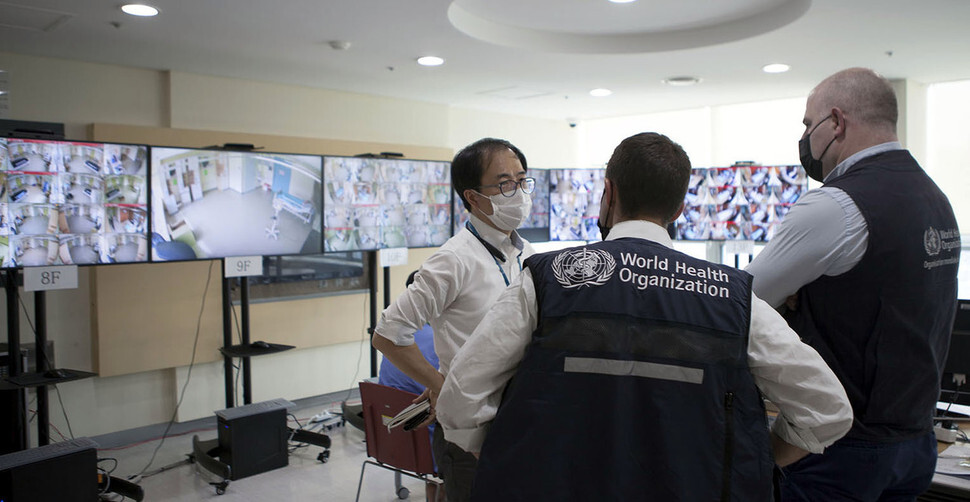hankyoreh
Links to other country sites 다른 나라 사이트 링크
S. Korea’s story from coronavirus nightmare to exemplar for countermeasures and prevention

The dramatic twists and turns in South Korea’s fight against COVID-19 are drawing global attention.
While the disease was raging in China, South Korea had been trying to prevent it from spreading domestically since the end of January. But its efforts seemed to fail when cases soared in late February following mass transmission among followers of the Shincheonji religious sect. Global media attention turned to South Korea as the government seemed helpless to prevent the surge in cases connected to Shincheonji. Countries around the world started taking defensive measures against South Korea. The number of countries restricting or banning entry from the country rapidly increased, reaching more than a hundred by Mar. 6.
But South Korean medical workers and public health authorities had implemented an aggressive testing regime to identify and treat infected individuals. When it became clear that this was effective at slowing the spread of the disease, the South Korean model started to gain international attention. In particular, US politicians and media highlighted the effectiveness of South Korea’s proactive testing program while criticizing the Trump administration’s botched response.
This comparison was explicitly drawn by Rep. Carolyn Maloney during a COVID-19 hearing at the US House of Representatives: “South Korea [. . .] can test 15,000 people a day. South Korea can test more people in one day than we tested over the past two months. [. . .] Why are we so far behind Korea?”
“South Korea was one of the worst-hit countries in the early stages of the coronavirus outbreak. But an aggressive response has made it one of the exemplars in the midst of the pandemic,” the Washington Post said in a Mar. 16 article titled, “South Korea’s coronavirus success story underscores how the US initially failed.”
As COVID-19 spreads throughout Europe and the world, interest in the South Korean model has gone global. “A month ago, the Republic of Korea [South Korea] was faced with accelerating community transmission. But it didn’t surrender,” said Dr. Tedros Adhanom Ghebreyesus, director-general of the World Health Organization (WHO), during a video briefing at the WHO headquarters in Geneva, Switzerland, on Mar. 18.
“[South Korea] developed an innovative testing strategy and expanded lab capacity; it rationed the use of masks. [. . .] WHO is working in solidarity with other countries with community transmission to apply the lessons learned in Korea and elsewhere.”
S. Korea’s democratic model vs. China’s authoritarian oneThe drive-through testing model pioneered in South Korea has also been adopted in the US, the UK, Germany, Belgium and Japan. Requests to export South Korea’s diagnosis kits have been pouring in from other countries. Some have also been asking for South Korean experts to visit and for assistance from South Korea’s public health authorities, according to the Ministry of Foreign Affairs.
Such interest in the South Korean model is partly focused on the contrast that can be drawn with the Chinese model. The Chinese authorities failed in their initial response to the spread of the virus in Wuhan after suppressing information about the outbreak. But China did manage to stop the spread of the virus through authoritarian methods, such as completely controlling the everyday lives of its citizens and putting 11 million people in Wuhan and 50 million in Hubei Province on lockdown. Since then, it has declared the a “great victory” and praised the excellence of the Chinese system.
Under these circumstances, American and European newspapers have focused on the South Korean model’s effectiveness at stemming the tide of the disease without infringing on individual rights and autonomy, in contrast with China’s authoritarian model. Since no definite model has yet been presented by the US, Europe or Japan, South Korea is effectively running a nation-sized experiment in the possibility of effectively responding to a social disaster while maintaining a democratic system.
By Park Min-hee, staff reporter
Please direct comments or questions to [english@hani.co.kr]

Editorial・opinion
![[Column] Season 2 of special prosecutor probe may be coming to Korea soon [Column] Season 2 of special prosecutor probe may be coming to Korea soon](https://flexible.img.hani.co.kr/flexible/normal/500/300/imgdb/original/2024/0426/3317141030699447.jpg) [Column] Season 2 of special prosecutor probe may be coming to Korea soon
[Column] Season 2 of special prosecutor probe may be coming to Korea soon![[Column] Park Geun-hye déjà vu in Yoon Suk-yeol [Column] Park Geun-hye déjà vu in Yoon Suk-yeol](https://flexible.img.hani.co.kr/flexible/normal/500/300/imgdb/original/2024/0424/651713945113788.jpg) [Column] Park Geun-hye déjà vu in Yoon Suk-yeol
[Column] Park Geun-hye déjà vu in Yoon Suk-yeol- [Editorial] New weight of N. Korea’s nuclear threats makes dialogue all the more urgent
- [Guest essay] The real reason Korea’s new right wants to dub Rhee a founding father
- [Column] ‘Choson’: Is it time we start referring to N. Korea in its own terms?
- [Editorial] Japan’s rewriting of history with Korea has gone too far
- [Column] The president’s questionable capacity for dialogue
- [Column] Are chaebol firms just pizza pies for families to divvy up as they please?
- [Column] Has Korea, too, crossed the Rubicon on China?
- [Correspondent’s column] In Japan’s alliance with US, echoes of its past alliances with UK
Most viewed articles
- 1After election rout, Yoon’s left with 3 choices for dealing with the opposition
- 2AI is catching up with humans at a ‘shocking’ rate
- 3Noting shared ‘values,’ Korea hints at passport-free travel with Japan
- 4Two factors that’ll decide if Korea’s economy keeps on its upward trend
- 5Why Kim Jong-un is scrapping the term ‘Day of the Sun’ and toning down fanfare for predecessors
- 6South Korea officially an aged society just 17 years after becoming aging society
- 7Korea’s 1.3% growth in Q1 signals ‘textbook’ return to growth, says government
- 8Is Japan about to snatch control of Line messenger from Korea’s Naver?
- 91 in 5 unwed Korean women want child-free life, study shows
- 10[Reportage] On US campuses, student risk arrest as they call for divestment from Israel